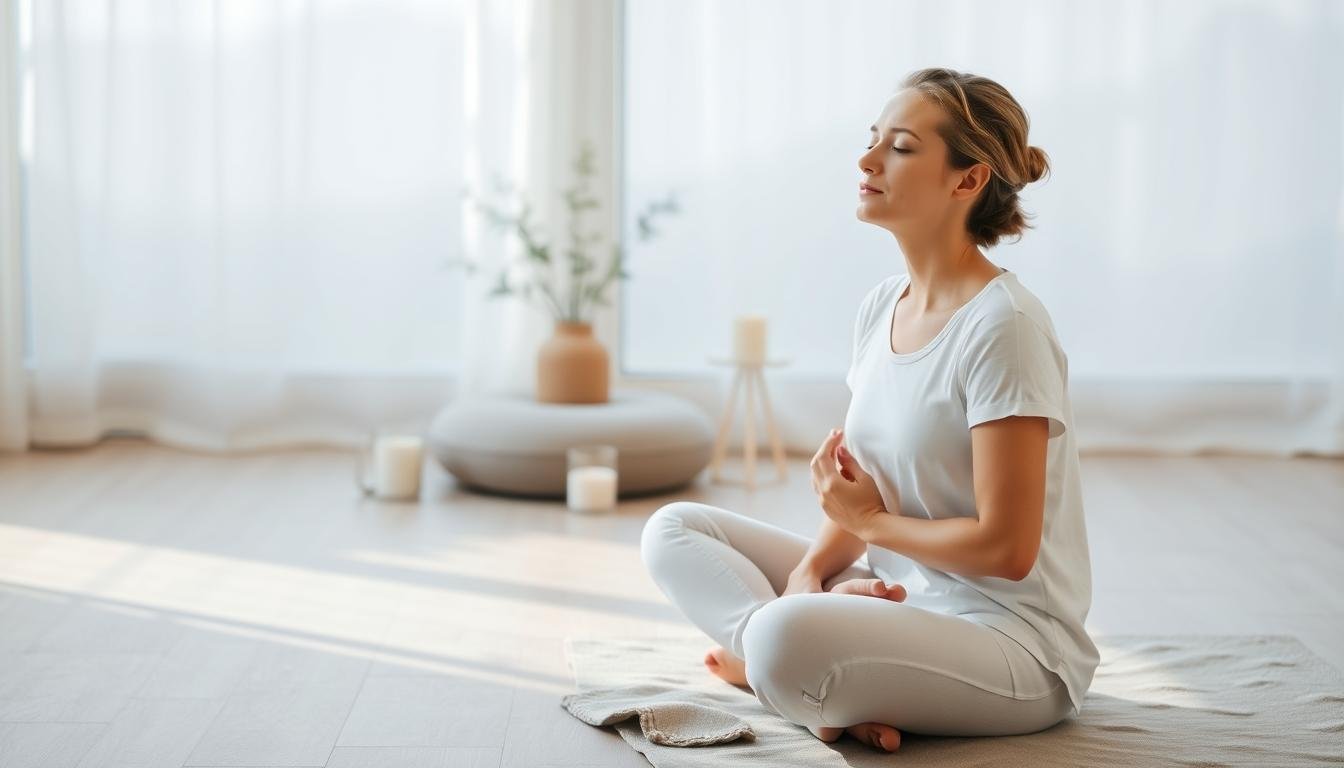We often underestimate the power of our breath, yet it’s a potent tool for managing stress and enhancing overall well-being. Breathing exercises can calm the mind, reduce anxiety, and boost our mood. In today’s fast-paced world, finding instant stress relief is crucial for maintaining a healthy balance.
By incorporating simple yet effective breathwork techniques into our daily routine, we can better navigate life’s challenges. This article will explore five powerful methods that can be practiced anywhere, anytime, to help you find calm and composure in the midst of chaos.
Key Takeaways
- Discover simple breathing exercises for instant stress relief
- Learn how to calm your mind and reduce anxiety
- Explore the benefits of incorporating breathwork into your daily routine
- Find out how to boost your mood with effective breathing techniques
- Understand the importance of breathing exercises for overall well-being
The Stress-Breath Connection: Why Breathing Matters
Breathing is not just a basic bodily function; it’s also a critical factor in how we manage stress. When we’re under stress, our breathing patterns change significantly, often in ways that can worsen our stress levels. Understanding this connection is key to leveraging breathwork techniques for stress relief.

How Stress Hijacks Your Breathing Patterns
When we experience stress, our body’s “fight or flight” response is triggered, causing our breathing to become shallower and more rapid. This change in breathing pattern can lead to a decrease in oxygenation of the body and brain, potentially exacerbating feelings of anxiety and tension. By becoming aware of these changes, we can begin to use breathwork techniques to counteract the negative effects of stress on our breathing.
| Breathing Pattern | Effect on Stress | Benefit of Breathwork Techniques |
|---|---|---|
| Shallow and Rapid | Increases Stress | Reduces Anxiety |
| Deep and Slow | Reduces Stress | Promotes Relaxation |
The Physiological Impact of Proper Breathing
Proper breathing techniques, such as those used in breathwork, can have a profound impact on our physiological state. By engaging in deep, controlled breathing, we can stimulate the parasympathetic nervous system, which promotes relaxation and reduces stress. This can lead to a range of benefits, including lowered blood pressure, reduced muscle tension, and improved overall well-being.
By incorporating breathwork techniques into our daily routine, we can better manage stress and improve our physiological response to tension. This makes understanding and practicing proper breathing a vital component of any stress management strategy.
The Science Behind Effective Breathwork Techniques
Understanding the science behind breathwork is crucial for harnessing its full potential in stress relief. Breathwork techniques have been shown to have a direct impact on our nervous system, influencing both our neurological state and our physiological responses. By exploring the scientific basis of these techniques, we can better appreciate their benefits and how they contribute to overall well-being.
Neurological Benefits of Controlled Breathing
Controlled breathing, a core component of breathwork techniques, has been found to have significant neurological benefits. It can lead to a decrease in stress hormones and promote a sense of calm and relaxation. Studies have shown that conscious breathing practices can alter brain activity patterns, enhancing areas related to emotional regulation and reducing those associated with stress and anxiety.
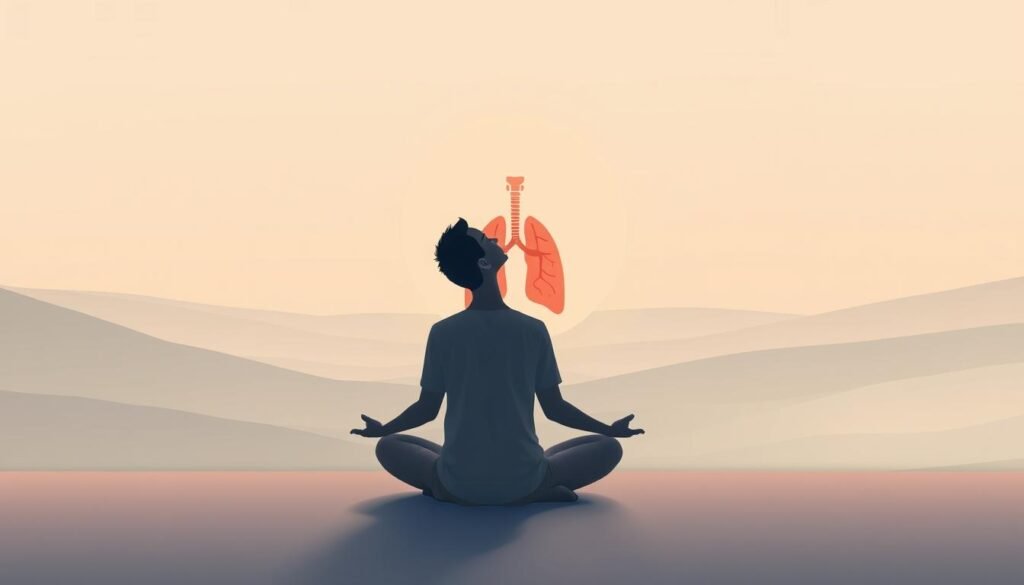
| Neurological Benefit | Description |
|---|---|
| Reduced Stress Hormones | Decreases the production of stress hormones like cortisol, leading to a calmer state. |
| Enhanced Emotional Regulation | Improves the ability to manage emotions, reducing the impact of stress and anxiety. |
| Altered Brain Activity | Changes brain activity patterns to favor relaxation and reduce stress. |
How Breathwork Activates Your Parasympathetic Nervous System
Breathwork techniques are particularly effective at activating the parasympathetic nervous system (PNS), which is responsible for promoting relaxation and reducing stress. By consciously controlling breathing patterns, individuals can stimulate the PNS, counteracting the effects of stress and anxiety. This activation can lead to a range of benefits, including improved heart rate variability and reduced blood pressure.
The parasympathetic nervous system’s response to breathwork can be seen in its ability to:
- Promote relaxation and reduce stress
- Improve heart rate variability
- Enhance overall well-being
When to Practice These Breathwork Techniques
Understanding when to practice breathwork techniques is crucial for maximizing their stress-relieving benefits. By identifying the right moments to breathe, you can better manage your stress levels and improve overall well-being.
Recognizing Your Personal Stress Triggers
To effectively use breathwork, it’s essential to recognize your personal stress triggers. These can be specific situations, emotions, or even thoughts that cause you to feel stressed or anxious. By being aware of these triggers, you can prepare yourself to practice breathwork techniques at the right moments.
Common stress triggers include work-related pressures, personal relationship issues, and significant life changes. Once you’re aware of your triggers, you can develop a proactive approach to managing stress through breathwork.
Creating Strategic Breathing Moments Throughout Your Day
Strategic breathing moments can be integrated into your daily routine to provide regular stress relief. This can include practicing breathwork during your morning routine, right before a challenging task, or during your lunch break.
By incorporating breathwork into your daily schedule, you can create a consistent practice that helps manage stress and improve focus. Consider setting reminders or cues throughout the day to practice your chosen breathwork techniques.
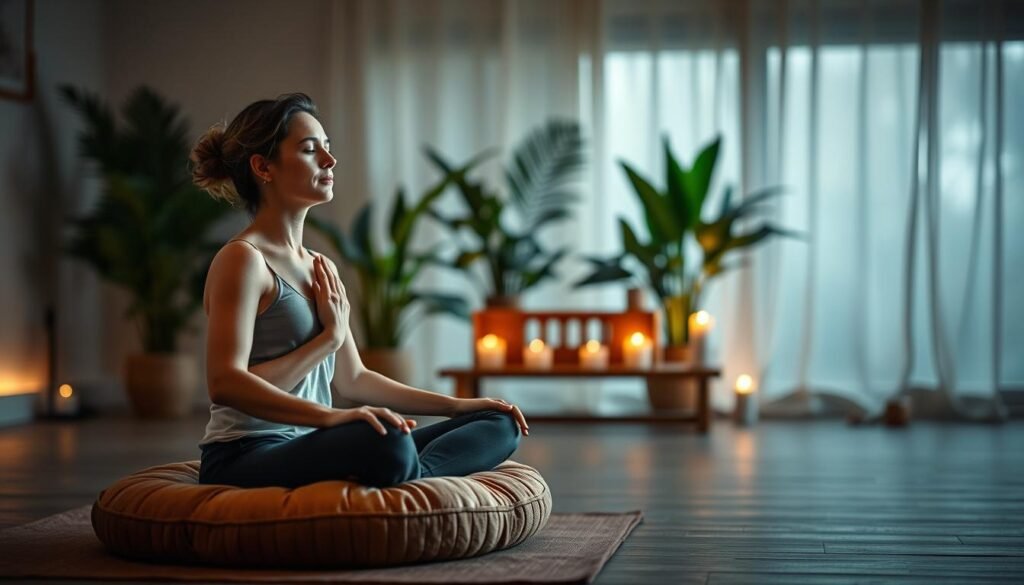
Technique1: Box Breathing for Immediate Calm
When it comes to managing stress, one of the most effective breathwork techniques is box breathing. This method involves breathing in for a count of 4, holding your breath for a count of 4, exhaling for a count of 4, and then holding your breath again for a count of 4, creating a “box” shape with your breath.
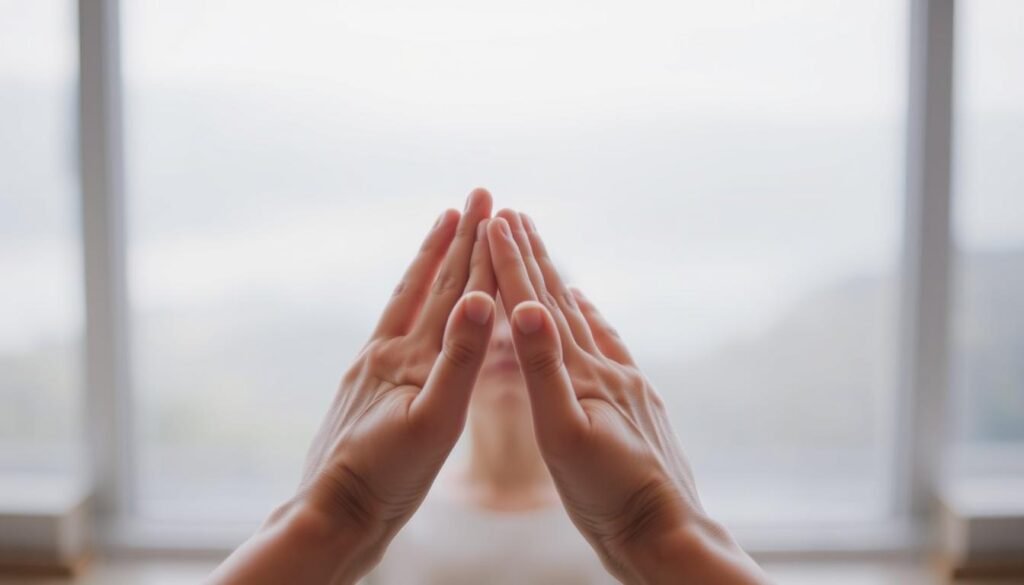
Step-by-Step Box Breathing Instructions
To practice box breathing effectively, follow these steps carefully. First, ensure you are in a comfortable position, either sitting or standing, with your back straight.
Proper Posture and Environment Setup
Find a quiet, comfortable space where you can sit or stand without distractions. Maintain a straight posture to allow for optimal lung expansion. You can close your eyes to minimize visual distractions and focus on your breath.
Counting Methods and Visualization Tips
To enhance your box breathing practice, you can use visualization techniques. Imagine a box in your mind and trace its edges as you breathe in, hold, breathe out, and hold again. You can also count slowly to yourself or use a metronome app to help maintain the rhythm.
Benefits and Optimal Situations for Box Breathing
Box breathing offers numerous benefits, including reduced stress and anxiety, improved focus, and enhanced relaxation. It’s particularly useful in situations where you need to calm down quickly, such as before a presentation, during a stressful commute, or when feeling overwhelmed at work.
By incorporating box breathing into your daily routine, you can develop greater control over your stress response and improve your overall well-being. Regular practice can also enhance your ability to stay focused and calm under pressure.
Technique2: The 4-7-8 Breathing Method for Anxiety Relief
The 4-7-8 Breathing Method, also known as the Relaxation Breath, is a powerful technique for calming the mind and body. This method, popularized by Dr. Andrew Weil, is based on the principle of slowing down one’s breathing to induce a state of relaxation.

Mastering the 4-7-8 Breathing Sequence
To practice the 4-7-8 Breathing Method, start by finding a comfortable seated position with your back straight. Place the tip of your tongue behind your upper teeth, and keep it there throughout the exercise.
The sequence involves breathing in through your nose for a count of 4, holding your breath for a count of 7, and exhaling through your mouth for a count of 8. This cycle is repeated for several rounds.
Beginner Modifications for Comfort
For beginners, it’s advisable to start with a shorter cycle, such as 3-5-7 or even 2-3-4, and gradually increase as you become more comfortable with the technique. It’s also essential to listen to your body and stop if you experience any discomfort.
Advanced Practice Recommendations
As you become more adept at the 4-7-8 Breathing Method, you can increase the number of cycles and practice it more frequently. Advanced practitioners often use this technique during periods of high stress or before bed to promote a restful night’s sleep.
When and Why to Use 4-7-8 Breathing
The 4-7-8 Breathing Method is particularly effective for anxiety relief because it activates the parasympathetic nervous system, promoting relaxation and reducing stress. It’s beneficial to practice this technique during moments of anxiety or as a regular part of your daily routine to enhance overall well-being.
By incorporating the 4-7-8 Breathing Method into your breathwork techniques practice, you can develop a powerful tool for managing anxiety and improving your mental health.
Technique3: Diaphragmatic Breathing for Deep Relaxation
To combat stress, one of the most effective breathwork techniques is diaphragmatic breathing, also known as belly breathing. This technique engages the diaphragm, the muscle that separates the chest and abdominal cavities, to facilitate deep, relaxing breaths.

Perfecting Your Diaphragmatic Breathing Technique
Mastering diaphragmatic breathing requires practice and the right guidance. To start, it’s essential to understand the proper placement of your hands to monitor your breathing and the progression from lying to seated practice.
Hand Placement for Proper Feedback
Place one hand on your upper chest and the other on your belly. As you breathe in, your belly should rise while your chest remains still. This hand placement provides immediate feedback on whether you’re using your diaphragm correctly.
Progression from Lying to Seated Practice
Begin by practicing diaphragmatic breathing while lying on your back. Once comfortable, progress to sitting in a chair. This progression helps strengthen your diaphragm and makes the technique more versatile for daily use.
Health Benefits Beyond Stress Management
Diaphragmatic breathing offers numerous health benefits beyond stress reduction. These include:
- Improved lung efficiency
- Enhanced oxygenation of the body
- Better posture due to strengthened core muscles
- Reduced symptoms of anxiety and depression
| Benefit | Description |
|---|---|
| Improved Lung Efficiency | Diaphragmatic breathing helps in utilizing the lungs to their full capacity, thereby improving overall respiratory function. |
| Enhanced Oxygenation | By taking deeper breaths, the body receives more oxygen, which can improve energy levels and overall well-being. |
| Better Posture | The strengthening of core muscles through diaphragmatic breathing can lead to improved posture. |
By incorporating diaphragmatic breathing into your daily routine, you can experience these benefits firsthand and enjoy a more relaxed, healthier life.
Technique4: Alternate Nostril Breathing for Mental Balance
For those seeking mental equilibrium, Alternate Nostril Breathing is a valuable breathwork technique to explore. This ancient practice has been used for centuries to balance the mind and prepare for meditation.
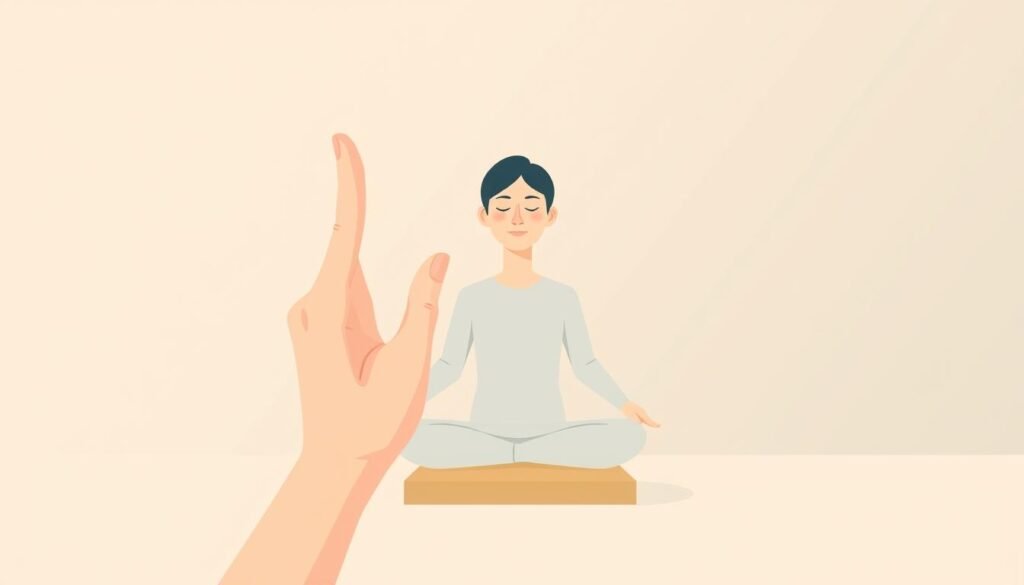
Correct Hand Position and Breathing Pattern
To practice Alternate Nostril Breathing, one must first learn the correct hand position and breathing pattern. The traditional method involves using the right hand to control the nostrils.
Traditional Mudra Technique
The traditional mudra technique involves folding the index and middle fingers towards the palm, leaving the thumb, ring finger, and pinky free. The thumb is used to close the right nostril, and the ring finger is used to close the left nostril. This precise hand position is crucial for the technique’s effectiveness.
Simplified Approach for Beginners
For beginners, a simplified approach can be adopted by simply using the thumb and ring finger to close the nostrils without adopting the full mudra. This makes the technique more accessible while still being effective.
Balancing Left and Right Brain Activity
Alternate Nostril Breathing is believed to balance the left and right brain activity by alternating the breath between the two nostrils. This balance is thought to calm the mind, reduce stress, and improve cognitive function. Regular practice can lead to improved mental clarity and a sense of well-being.
- Enhances mental balance and calmness
- Prepares the mind for meditation
- Can improve cognitive function and clarity
By incorporating Alternate Nostril Breathing into your daily routine, you can experience these benefits firsthand. As with any breathwork technique, consistency is key to achieving the desired outcomes.
Technique5: Coherent Breathing for Heart-Mind Harmony
Coherent breathing is a powerful technique that harmonizes the heart and mind, offering instant stress relief. This method involves breathing at a specific rate to synchronize heart rate variability (HRV) with the body’s natural rhythms, promoting balance and reducing stress.
Finding Your Optimal Breathing Rhythm
To practice coherent breathing effectively, it’s crucial to find your optimal breathing rhythm. This involves identifying a breathing rate that synchronizes your heart rate with your respiratory cycle.
Using Timing Tools and Apps
Several apps and devices can guide you in achieving the optimal breathing rate. These tools provide visual or auditory cues to help you pace your breath, making it easier to enter a state of coherence. Popular options include HeartMath and various guided meditation apps that offer breathing exercises.
Breath Pacing Techniques
Breath pacing techniques are essential for maintaining a consistent breathing rhythm. One common method is to breathe at a rate of 5-7 breaths per minute, which is considered optimal for most adults. You can use a metronome or a guided recording to help you maintain this pace.
Evidence-Based Benefits for Stress and Anxiety
Research has shown that coherent breathing can have a significant impact on both stress and anxiety. By reducing cortisol levels and improving heart rate variability, coherent breathing helps to calm the nervous system. Studies have demonstrated its effectiveness in various populations, from individuals with anxiety disorders to those experiencing chronic stress.
| Benefit | Description | Impact |
|---|---|---|
| Reduced Stress | Lowers cortisol levels | Decreases anxiety and tension |
| Improved HRV | Synchronizes heart rate with breathing | Enhances cardiovascular health |
| Increased Clarity | Improves mental focus and clarity | Boosts productivity and decision-making |
By incorporating coherent breathing into your daily routine, you can experience these benefits firsthand. Regular practice can lead to long-term improvements in both physical and mental well-being.
Common Breathwork Techniques Mistakes and How to Avoid Them
When practicing breathwork techniques, it’s easy to fall into common pitfalls that can undermine their effectiveness. Being aware of these potential mistakes can help you practice more safely and effectively.
Breathing Too Deeply or Forcefully
One common mistake is breathing too deeply or forcefully, which can lead to hyperventilation or discomfort. To avoid this, start with gentle, shallow breaths and gradually increase depth as you become more comfortable with the technique. It’s also helpful to listen to your body and adjust your breathing accordingly.
Inconsistent Practice Patterns
Inconsistent practice is another mistake that can reduce the effectiveness of breathwork techniques. Establishing a regular practice routine can help you experience more consistent benefits. Even a few minutes of practice each day can be more beneficial than longer, less frequent sessions.
Ignoring Physical Limitations or Conditions
Ignoring physical limitations or health conditions is a significant mistake when practicing breathwork techniques. It’s essential to consider any health concerns or physical limitations before starting a breathwork practice. For example, certain techniques may not be suitable for individuals with respiratory conditions. Consulting with a healthcare professional can provide guidance tailored to your specific needs.
By being aware of these common mistakes and taking steps to avoid them, you can enhance the safety and effectiveness of your breathwork practice. Regular, mindful practice can lead to better stress management and overall well-being.
- Start with gentle, controlled breathing to avoid discomfort.
- Establish a consistent practice routine for better results.
- Consider your physical limitations and health conditions before practicing.
Conclusion: Transforming Your Stress Response One Breath at a Time
We’ve explored five powerful breathwork techniques that can help you manage stress and anxiety. By incorporating box breathing, the 4-7-8 method, diaphragmatic breathing, alternate nostril breathing, and coherent breathing into your daily routine, you can transform your stress response and improve your overall well-being.
These breathwork techniques offer a range of benefits, from immediate calm and relaxation to long-term stress management and improved mental balance. By practicing these techniques regularly, you can develop greater resilience to stress and enhance your overall quality of life.
As you continue to practice these breathwork techniques, you’ll become more attuned to your body’s response to stress and more skilled at managing it. By making breathwork a part of your daily routine, you can take control of your stress response and cultivate a greater sense of calm and well-being.

